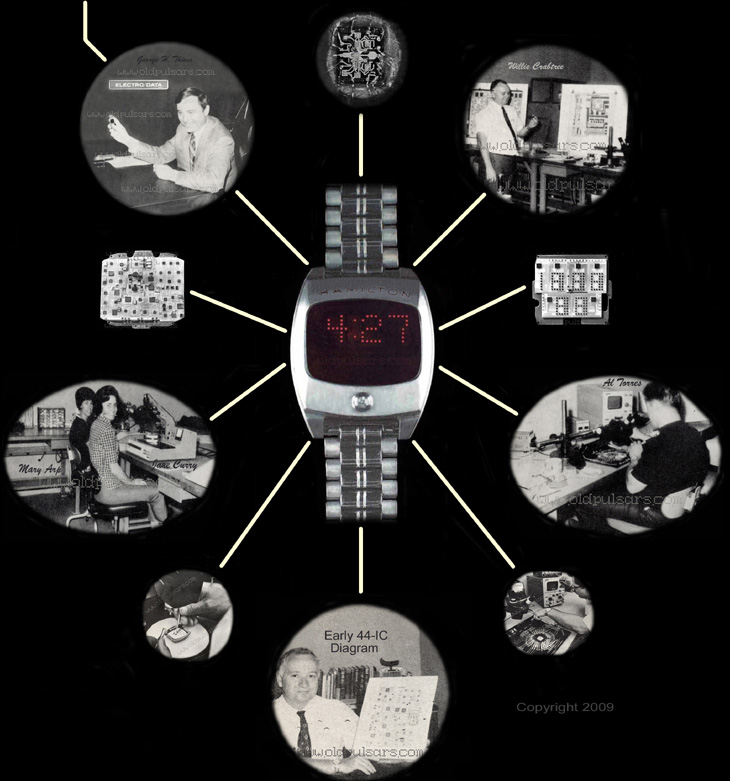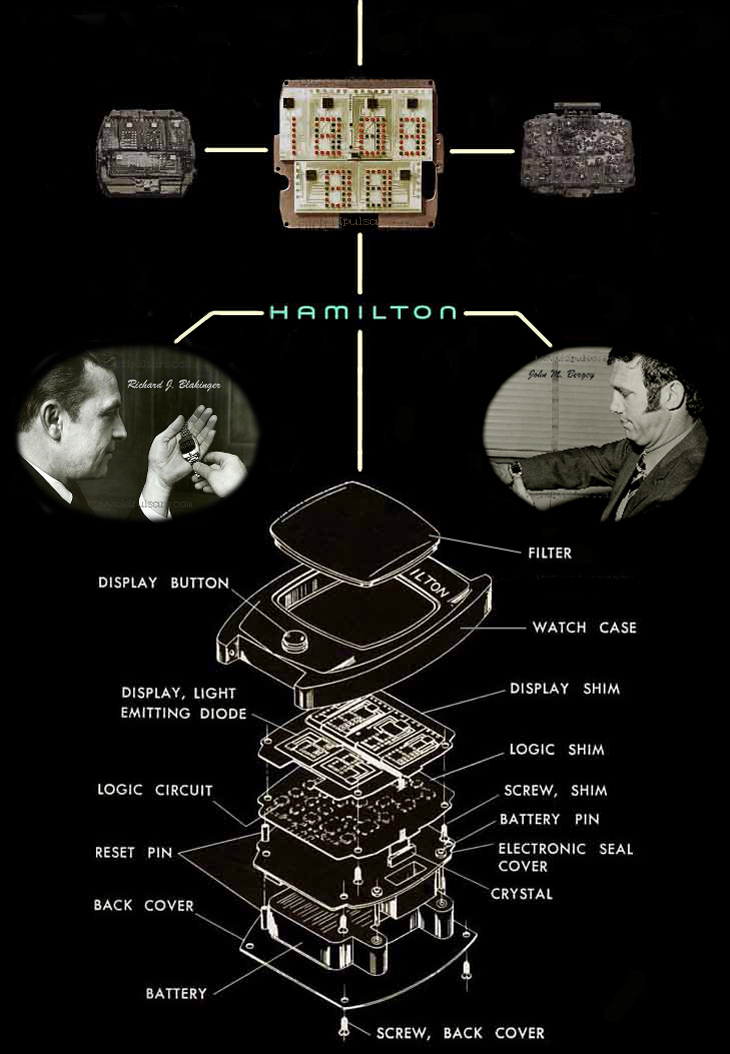|
It
has taken more than a decade to gather the facts related to the
development of the first digital wristwatch. We will concentrate on the
development of the watch and not debate what has already been
historically documented. These accounts are the most accurate to date of
�Who invented the Digital watch�. In the event that additional facts
come to light, we will make updates. We do not claim these accounts to
be 100% complete, but that they are historically correct, and that we
possess the documentation to back up these events. No
portions of this article may be reproduced without permission.
�The
World�s First Digital LED
Watch�
. . . . That�s quite an honor for anyone to claim, especially when it
was the first new way to tell time in 500 years. Henry
B. Fried considered
the digital watch as
" the most dramatic step forward since the invention of the hairspring
in 1675 ".
Only two companies,
and a handful of people, can be recognized for this invention. Over the
years there have been several people who have falsely claimed to be the
inventor. But only
The Hamilton
Watch Co.
and
Electro/Data,
Inc.
can take credit for this milestone in horology.
Both companies
contributed to the development of the first digital watch. Some sway to
one side or the other, but the evidence proves this project was a team
effort. No one person, or company, can claim to be the sole inventor.
History does have it right, it was a joint effort!
Because the first
prototype was basically assembled at the Electro/Data facility in
Garland
Texas, we will refer to the first tangible development as the
�E/D
Prototype� a.k.a., �The Mystery Watch�.
(The contributions and claims from the
Hamilton
side will be covered in another section of this website.)
George
H. Thiess:
founded
Electro/Data, Inc. in May of 1966. Thiess was born in
St. Louis, and was an A.F. veteran of the Korean War.
He earned a B.S. degree in
Physics Engineering in 1958. Thiess spent three years at Texas Instruments, and three more at Microwave Physics Corporation, before leaving to start his own
instrument company. A former engineer that worked at Electro/Data
described Thiess as a �visionary� with incredible ambition and
foresight. A 1970 article in a local jeweler�s magazine, which first
reported on the �Mystery Watch� in 1968, listed some of Thiess�
visions. One vision was the need for �an all electric car that could
go 60 mph and not need a charge for 240 miles� . . . can you say Tesla.
Another vision came from wearing a $10.95 Timex which made Thiess
realize the need for
�a more accurate watch�.
Even after Thiess was
ousted from Electro/Data, he started Electro Research, Inc. in
August of 1971. They made three clock models, a desk, a wall, and a
floor clock. He later founded Chronex
Watch Corporation in July of 1973. Chronex was to make LED digital
watches, and offer the watch industry with training to service digital
watches. From a small boy, Thiess was interested in electronics, so
it�s no surprise that he had a big hand in developing the first
digital watch.
In 1979, you would
find Thiess at Electric Motor Cars, Inc. where he, and partner Jack
Hooker, invented that electric car Thiess envisioned back in the 60�s.
Their prototype ran on sea water by converting the water into magnesium
used to charge the batteries. This seemed to be another promising
vision, but unfortunately, it ended in 1986 without any notable
recognition.
Willie
Crabtree:
Earned both a BSEE & MSEE.
He
started his career at Bell Laboratories before being hired by Texas
Instruments in 1957. After twelve years at TI, he joined Electro/Data as
a project engineer and worked on the digital watch for the next four
years. After he completed his work on the prototype clock in 1969,
Crabtree worked with engineers at
Hamilton
to develop the first prototype digital watch. He was instrumental in the
development of the initial
44-IC module.
Crabtree headed the
digital watch department at Electro/Data after George Thiess was removed
and again was crucial in finishing the 491
25-IC modules
under
contract with Hamilton.
When E/D folded,
Crabtree moved over to American Time which was a surviving division of
E/D that had been privately purchased and run by James Short. Mr. Short
was the last CEO at Electro/Data. Crabtree eventually went back to Texas
Instruments and worked for seven years before he retired in 1991.
Electro/Data History:
The Company was founded in 1966 and went public in June of 1969.
The
8,800 sq. ft. facility was located at 1621 Jupiter Road
in Garland,
Texas. Electro/Data was a
scientifically oriented research, development and production company of
solid state microwave components and subsystems. One of Electro/Data�s
early projects was research & development on an instrument to
measure the universe.
In early 1968 Thiess had put together some sort of clock as
research to develop his watch. What exactly it looked like or how
complete it was is not known. This project is what was written about in
July of 1968. This was the first published article about Electro/Data's
efforts to develop a digital watch. Thiess used an Early
IC from Texas
Instruments in his first efforts. In the spring of 1969, Thiess recruited
engineer Willie Crabtree to help develop that �more accurate watch�
(the Mystery Watch).
By the
winter of 1969, Electro/Data had developed a prototype clock with
an LED dot-matrix display. The prototype was made from
�off-the-shelf�
components, said Thiess. One of the key components
was the
HP 5082-7000
numerical display.
At the onset, only 4
employees, of the 30 total, work on the project.
On December 1st,
1969, Electro/Data entered into a contract with Hamilton Watch Co. to
jointly develop the world�s first digital watch.
Hamilton
had also developed a digital clock and was looking to reduce it down to
a wristwatch.
Hamilton
realized Electro/Data was already better equipped, and experienced, in
the field of microelectronics. In the 1969/1970 winter, a large scale breadboard
for a digital watch was completed. The first solid state module reduced
down to a size that could fit into a watchcase was the
44-IC module.
Hamilton worked with case designers at
Star Watch
Case Co. and supplied the
stainless steel cases to Electro/Data. The first prototype watch housing the
44-IC module
was first seen
on the Johnny Carson Show on May 5th, 1970. Only six such
watches were made. Reliability problems with the
44-IC module
forced the development of a second generation,
25-IC module,
which was far less complex. This was the electronic module which was
eventually delivered to Hamilton
for the Pulsar. Unfortunately, the
25-IC module
was also failing
within months of the first Pulsars sold to the public.
Hamilton was forced to improvise using their own electronic module they
had secretly developed. Fortunately, it was already finished in
time to rescue the Pulsar. The fact that Hamilton could recall the
watches already sold, and retrofit those that hadn't, without publicity,
probably changed the history of the LED digital watch industry. One can
only image how this would have been used against the digital watch by
the analog watch industry. There was already much talk about what
the digital watch could do to the watch industry. Fear was an understatement,
and this would have been just the type of fuel they needed to stop the
digital watch in its tracks.
Substantial growth at
Electro Data, along with many lucrative contracts in the microwave
division, made the company very profitable. Electro/Data�s other
profitable division, American Time, made time/temperature clocks and
signs for the commercial market. In an effort to make Electro/Data more
attractive to investors, Electro/Data acquired Care Electronics and
merged in October of 1971. Care was a company located in
Huntsville,
Alabama, founded by Peter D. Petroff. At that time, Care was developing
electronic heart monitoring and other medical equipment. Petroff 's
company was deeply in debt, but the Board of Directors felt that Care
could become profitable. They were so convinced that the Board of
Directors voted in Peter Petroff as the new
CEO. For some reason, George Thiess was no longer with the
company as of August of 1971? Willie Crabtree would remain as the chief engineer in charge of the
Mystery Watch.
After several months
of heavy losses, and realizing their mistakes, in March of 1972, the
Directors replaced Petroff with James D. Short. Mr. Petroff would revert
back to the president of the Care subsidiary (still located in
Alabama
). In a 1973 newspaper article, Short said
�Care turned out to be a
lemon�
and
�management changes resulting from the merge set a coarse
that couldn�t be corrected in time�. Unfortunately, the large debts
from Care absorbed the Electro/Data assets, and their creditors forced
them into bankruptcy on
April 12, 1973.
Commentary:
What�s
amazing is that George Thiess, the very man who founded the company,
wasn�t there when the joint efforts with Hamilton
came to fruition. Thiess was making plans to start his own clock company
when the Pulsar was offered to the public in April of 1972. How could
this happen? Maybe it was that Thiess didn�t fit the corporate mold?
In a May 1970 article,
�The Mystery Watch Revealed�, the editor (who
interviewed Thiess at Electro/Data) described him as outspoken and
non-political. In the corporate world, that demeanor doesn�t set well
with the Board Room. Possibly it was because Petroff came from NASA, and
the board felt his prestige was better suited for the company. One can
only imagine the animosity Thiess must have had about the events that
took place at Electro/Data.
It seems Thiess fell
victim to his own success by building a company that was profitable.
His
decision to go public, and sell stocks to help fund his visions, allowed
outsiders to make decisions that Thiess would not have made on his own.
Had Thiess continued on as CEO, and there was no merger with Care
Electronics, the history of the digital watch may have been written
differently. If Thiess had the funds and resources that
Hamilton
enjoyed, he likely could have shared much of the success that history
has given Hamilton.
In retrospect, when
Thiess conceived his vision, he never documented it. Even when a 1968
magazine article mentioned Thiess was working on a �Mystery Watch�,
Thiess still didn�t protect his vision. Had Electro/Data continued
without teaming up with Hamilton, there would have been many legal issues to overcome.
Much of the
circuitry for a digital watch had already been filed for at the patent
office by Hamilton
in 1968. There were many other patents as well that would have prevented
Electro/Data from solely claiming the invention. In fact, Electro/Data
was somewhat at the mercy of
Hamilton
due to infringement laws.
It should be noted
that a well documented timeline refutes the claims that Peter Petroff �invented the Digital watch�.
Actually, from all indications, it
would appear that Mr. Petroff had nothing to do with the invention.
As
the CEO of Electro/Data for a short period of time, he could have
possibly had some input for the 25-IC
module. To historically credit him
for this invention in any sense, would be highly inaccurate. By the time
Petroff became involved with E/D, the �Mystery Watch� had already
been revealed as the Pulsar, and all credits, had been historically
recorded.
Please
direct any questions here
Copyright
2010, www.oldpulsars.com
No
portions of this article may be reproduced without permission.
|

